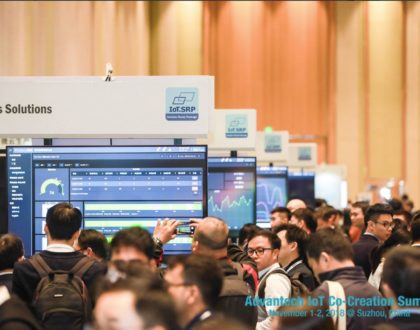Respect Your Elders — Even If They’re Machines
by Mike Fahrion
 Last week I talked to a sharp kid named Kevin. He was pretty young – early 20s – but you could tell he had a good head on his shoulders. Like most engineers his age, I’m sure he grew up networking, hacking and coding. And I’ll bet he was pretty good at it. But his brain was hard-wired for TCP.
Last week I talked to a sharp kid named Kevin. He was pretty young – early 20s – but you could tell he had a good head on his shoulders. Like most engineers his age, I’m sure he grew up networking, hacking and coding. And I’ll bet he was pretty good at it. But his brain was hard-wired for TCP.
Kevin’s company had sent him out to a customer’s job site to develop a proposal for integrating some of their warehouse automation systems into their business system. He did a great job of cataloging the system inputs and the devices that were already in place. Bar code scanners, scales, counters, micro PLCs, HMIs, card readers; you name it. There’s a lot of different equipment in a warehouse operation.
Not one of these devices had an Ethernet port. Some of them were older than Kevin himself, even though they were still perfectly functional and still quite capable of doing what they were designed to do. Kevin found devices with terminal blocks. He found DB9 ports, DB25 ports, RJ11s, and even a headphone jack. He then spent about an hour on his Android, Googling the various devices. Finally he called his boss.
Kevin told his boss that it looked to him like every one of the devices he’d investigated could be easily replaced by an equivalent, newer piece of equipment that would come with either an Ethernet port or Wi-Fi. Once the new equipment was in place, Kevin said, he figured that writing the middleware would be pretty straightforward, and that getting the data to the appropriate databases would be no problem.
Bear in mind that Kevin is a 20-something engineer, not a warehouse operator. He wasn’t thinking about what it would cost to replace all of this legacy equipment, the investment that the existing stuff already represented, or most importantly, the overwhelming customer resistance to ripping out stuff that’s successfully doing the job it was designed to do. He was thinking in TCP.
Needless to say, his more experienced boss told him that he was completely out of his mind. The customer had asked for an integration project, not a capital expenditure with a shopping list as long as your leg. Proposing that the customer should upgrade everything in sight wasn’t going to win any contracts. More likely, they’d chase him down the street with pitchforks and torches.
The boss also said, however, that data communications had been around longer than either Kevin or TCP, and that there were people who could explain it all to him. He gave Kevin my number and suggested giving me a call.
This all led to me giving Kevin the 30-minute primer on how to connect and talk to all things serial. They may not speak TCP, but they do speak. All you have to do is figure out how to listen. I pointed Kevin to our web site’s library of reading material, which pretty much contains everything you’ll ever need to know about dealing with RS-232/485, and other pre-Kevin, pre-TCP protocols. Kevin may not have been around in the 1980s, but B+B certainly was. I told Kevin to snoop around a bit, and then call me back when he felt like he was starting to get a handle on the subject.
As I said, Kevin seems like he’s got a good head on his shoulders. He called me back in just a couple of days, and he’s no longer proposing that the warehouse operation start over again from the ground up. We’re going to provide him with some serial servers that will let serial devices communicate across Ethernet networks. Many will be for wired Ethernet. But there will also be some Wi-Fi serial servers in the mix, to provide connectivity for mobile serial equipment. He’s also going to need a few isolated RS-232 to RS-485 converters. They’ll let him safely connect some of the more remote access control devices in a multi-drop network without replacing the existing wiring.
I also pointed out that he’ll want to connect his laptop’s USB port to some of the devices as he modifies settings here and there. And USB is notorious for its ability to surprise you with electrical transients in industrial settings – the ground references in a big operation like a warehouse are all over the place. He’ll need our isolated USB to RS-485 converter unless he wants to toast marshmallows over his laptop. It is never, ever, a good idea to connect your computer to devices that are wired into a 480V panel unless you’ve got isolation.
Kevin’s still got some work to do, but he’s on the right track now.
Even as we make the transition to the new IoT tech and all of its exciting possibilities, there will still be millions of pieces of pre-Kevin, pre-TCP, pre-IoT equipment chugging away all over the planet. They’re still doing their jobs; they’re still valuable, and they are still worthy of respect. You don’t have to send them off into retirement. All you have to is connect them to our modern networks.
Recommended Posts

Co-Creation, Paving the Way to a More Connected Future
November 27, 2018

The Benefits of a ‘Do It For Me’ Mentality in the IIoT
October 5, 2018

Why You Need to ‘Mind the Gap’ in Manufacturing Technology
August 31, 2018
